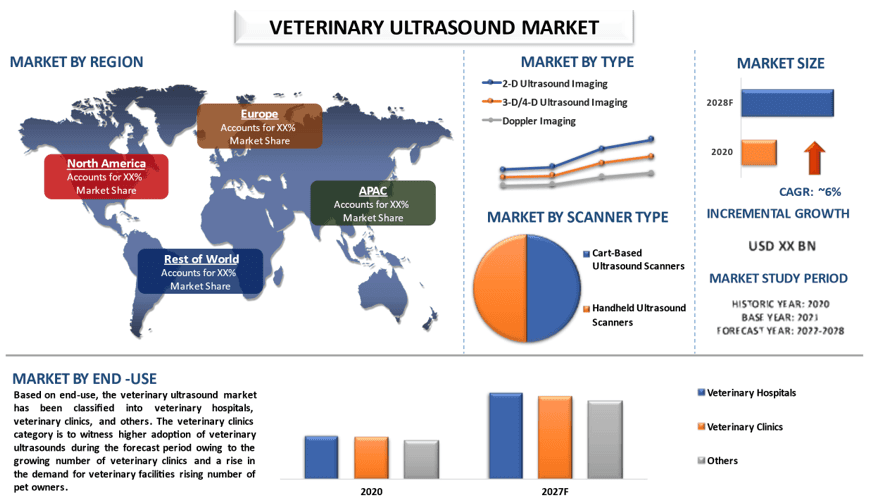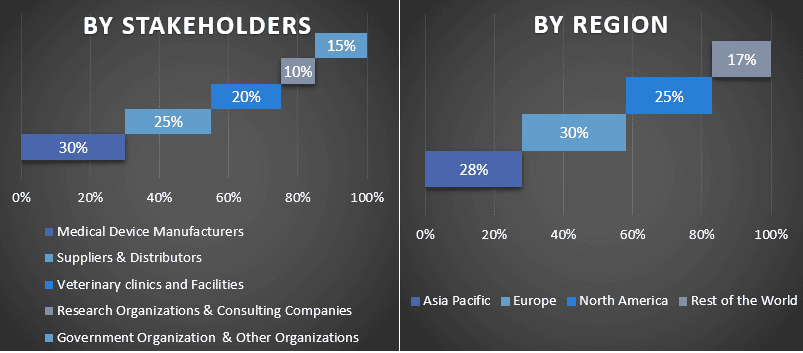- Home
- About Us
- Industry
- Services
- Reading
- Contact Us
Veterinary Ultrasound Market: Current Analysis and Forecast (2022-2028)
Emphasis on Type (2-D Ultrasound Imaging, 3-D/4-D Ultrasound Imaging, and Doppler Imaging); Scanner Type (Cart-Based Ultrasound Scanners and Handheld Ultrasound Scanners); End-Use (Veterinary Hospitals, Veterinary Clinics, and Others); and Region/Country

The global veterinary ultrasound market is expected to grow at a significant rate of around 6% during the forecast period. Animal diseases and disorders can be identified with the assistance of veterinary ultrasound scanners. High-frequency sound waves are the cause of the ultrasound image. Smaller probes and a higher frequency are used by veterinary ultrasound scanners than by human ultrasound scanners. Veterinary ultrasound scanners are used in the imaging of the stomach, chest, and heart areas of the animal. They are also used to monitor the size of the internal organs in animals. There are some driving factors that will propel the growth of the veterinary ultrasound market during the forecast period such as increasing demand for pet insurance technological advancements and the rising number of veterinary specialists in developing nations. For instance, according to the North American Pet Health Insurance Association (NAPHIA), in 2020, approximately 3.45 million pets in North America were covered by insurance. This number far exceeded the 2.81 million insured pets in North America in 2019.
Carestream Health, IDEXX Laboratories Inc., Sound, ESAOTE SPA, IMV, Hallmarq Veterinary Imaging, FUJIFILM Sonosite Inc., Shenzhen Mindray Bio-Medical Electronics Co. Ltd., Heska Corporation, Siemens Medical Solutions USA Inc. are some of the key players in the market. Several M&As along with partnerships have been undertaken by these players to facilitate customers with hi-tech and innovative products/technologies.
Insights Presented in the Report
“Amongst scanner type, cart-based ultrasound scanners category to witness robust CAGR during the forecast period”
Based on scanner type, the market is segmented into cart-based ultrasound scanners and handheld ultrasound scanners. Amongst, the cart-based ultrasound scanners category is to witness higher CAGR during the forecast period owing to their ease of use, these devices have a high adoption rate in veterinary clinics, hospitals, and diagnostic facilities. Furthermore, the market is anticipated to rise because of technological advancements by key industry players. For instance, in 2022, VMX Clarius Mobile Health unveiled its third-generation product range of high-performance handheld wireless ultrasound scanners for veterinarians. The new pocket-sized scanners are 30% lighter and smaller and available in the United States.
“Amongst end-use, the veterinary clinics to hold a significant share in the market in 2020”
On the basis of end-use, the market is categorized into veterinary hospitals, veterinary clinics, and others. Among these, veterinary clinics held a significant share of the market in 2020. This is mainly due to the increase in pet ownership, the growing demand for preventative healthcare options for animals, and the expansion of veterinary hospitals and clinics. These major factors are causing this growth of the market.
Furthermore, other end-uses like reference laboratories, diagnostic laboratories, Point-of-Care (POC) facilities, and academic & research centers are also anticipated to grow at the fastest growth rate during the forecast period owing to these facilities provide comprehensive diagnostic tests for delivering efficient results and consultation services of a specialist.
“North America to hold a significant share in the market”
For a better understanding of the market adoption of the veterinary ultrasound market industry, the market is analyzed based on its worldwide presence in the countries such as North America (U.S., Canada, Rest of North America), Europe (Germany, U.K., France, Spain, Italy, Rest of Europe), Asia-Pacific (China, Japan, India, Rest of Asia-Pacific), Rest of World. North America is anticipated to grow at a substantial CAGR during the forecast period. This is mainly due to the availability of major key players in the US, the increasing adoption of companion animals, the rising number of pet owners, the rising number of diagnostic examinations of pets in hospitals across the country, and the adoption of pet insurance in the region are expected to boost the growth of the market. For instance, according to the American Pet Products Association’s (APPA) 2021-2022 National Pet Owners Survey, around 70% of US households own a pet, equating to 90.5 million homes, including 45.3 million cats and 69 million dogs.
Reasons to buy this report:
- The study includes market sizing and forecasting analysis validated by authenticated key industry experts.
- The report presents a quick review of overall industry performance at one glance.
- The report covers an in-depth analysis of prominent industry peers with a primary focus on key business financials, product portfolio, expansion strategies, and recent developments.
- Detailed examination of drivers, restraints, key trends, and opportunities prevailing in the industry.
- The study comprehensively covers the market across different segments.
- Deep dive regional level analysis of the industry.
Customization Options:
The global veterinary ultrasound market can further be customized as per the requirement or any other market segment. Besides this, UMI understands that you may have your own business needs, hence feel free to connect with us to get a report that completely suits your requirements.
increasing pet ownership, expansion of veterinary hospitals and clinics, and the rising need for preventive healthcare solutions among animals are some of the factors contributing to this growth.
Some of the factors causing this growth include an increase in pet ownership, the expansion of veterinary hospitals and clinics, and the growing demand for preventative healthcare options for animals.
Table of Content
Research Methodology for the Veterinary Ultrasound Market Analysis (2022-2028)
Analyzing the historical market, estimating the current market, and forecasting the future market of the global veterinary ultrasound market were the three major steps undertaken to create and analyze the adoption of the veterinary ultrasound market in major regions globally. Exhaustive secondary research was conducted to collect the historical market numbers and estimate the current market size. Secondly, to validate these insights, numerous findings and assumptions were taken into consideration. Moreover, exhaustive primary interviews were also conducted, with industry experts across the value chain of the global veterinary ultrasound market. Post assumption and validation of market numbers through primary interviews, we employed a top-down/bottom-up approach to forecasting the complete market size. Thereafter, market breakdown and data triangulation methods were adopted to estimate and analyze the market size of segments and sub-segments of the industry pertains to. Detailed methodology is explained below:
Analysis of Historical Market Size
Step 1: In-Depth Study of Secondary Sources:
Detail secondary study was conducted to obtain the historical market size of the veterinary ultrasound market through company internal sources such as annual reports & financial statements, performance presentations, press releases, etc., and external sources including journals, news & articles, government publications, competitor publications, sector reports, third-party database, and other credible publications.
Step 2: Market Segmentation:
After obtaining the historical market size of the veterinary ultrasound market, we conducted a detailed secondary analysis to gather historical market insights and share for different segments & sub-segments for major regions. Major segments are included in the report as type, scanner type, and end-use. Further country-level analyses were conducted to evaluate the overall adoption of testing models in that region.
Step 3: Factor Analysis:
After acquiring the historical market size of different segments and sub-segments, we conducted a detailed factor analysis to estimate the current market size of the Veterinary Ultrasound Market. Further, we conducted factor analysis using dependent and independent variables such as various type, scanner type, and end-uses of veterinary ultrasound. A thorough analysis was conducted for demand and supply-side scenarios considering top partnerships, mergers and acquisitions, business expansion, and product launches in the veterinary ultrasound market sector across the globe.
Current Market Size Estimate & Forecast
Current Market Sizing: Based on actionable insights from the above 3 steps, we arrived at the current market size, key players in the global veterinary ultrasound market, and market shares of the segments. All the required percentage shares split, and market breakdowns were determined using the above-mentioned secondary approach and were verified through primary interviews.
Estimation & Forecasting: For market estimation and forecast, weights were assigned to different factors including drivers & trends, restraints, and opportunities available for the stakeholders. After analyzing these factors, relevant forecasting techniques i.e., the top-down/bottom-up approach were applied to arrive at the market forecast for 2028 for different segments and sub-segments across the major markets globally. The research methodology adopted to estimate the market size encompasses:
- The industry’s market size, in terms of revenue (USD) and the adoption rate of the veterinary ultrasound market across the major markets domestically
- All percentage shares, splits, and breakdowns of market segments and sub-segments
- Key players in the global veterinary ultrasound market in terms of products offered. Also, the growth strategies adopted by these players to compete in the fast-growing market
Market Size and Share Validation
Primary Research: In-depth interviews were conducted with the Key Opinion Leaders (KOLs) including Top Level Executives (CXO/VPs, Sales Head, Marketing Head, Operational Head, Regional Head, Country Head, etc.) across major regions. Primary research findings were then summarized, and statistical analysis was performed to prove the stated hypothesis. Inputs from primary research were consolidated with secondary findings, hence turning information into actionable insights.
Split of Primary Participants in Different Regions

Market Engineering
The data triangulation technique was employed to complete the overall market estimation and to arrive at precise statistical numbers for each segment and sub-segment of the global veterinary ultrasound market. Data was split into several segments & sub-segments post studying various parameters and trends in the areas of type, scanner type, and end-use in the global veterinary ultrasound market.
The main objective of the Global Veterinary Ultrasound Market Study
The current & future market trends of the global veterinary ultrasound market were pinpointed in the study. Investors can gain strategic insights to base their discretion for investments on the qualitative and quantitative analysis performed in the study. Current and future market trends determined the overall attractiveness of the market at a regional level, providing a platform for the industrial participant to exploit the untapped market to benefit from a first-mover advantage. Other quantitative goals of the studies include:
- Analyze the current and forecast market size of the veterinary ultrasound market in terms of value (USD). Also, analyze the current and forecast market size of different segments and sub-segments
- Segments in the study include areas of type, scanner type, and end-use.
- Define and analysis of the regulatory framework for the veterinary ultrasound industry.
- Analyze the value chain involved with the presence of various intermediaries, along with analyzing customer and competitor behaviors of the industry.
- Analyze the current and forecast market size of the veterinary ultrasound market for the major region.
- Major countries of regions studied in the report include Asia Pacific, Europe, North America, and the Rest of the World.
- Company profiles of the Veterinary Ultrasound Market and the growth strategies adopted by the market players to sustain in the fast-growing market
- Deep dive regional level analysis of the industry
Related Reports
Customers who bought this item also bought










